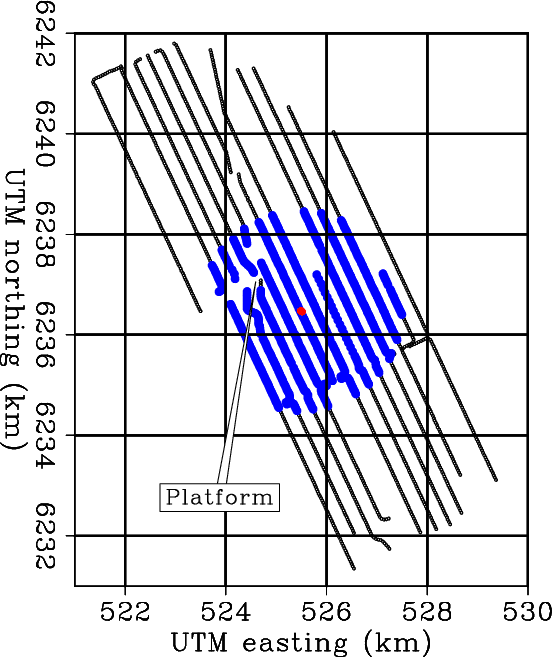|
|
|
|
Correlation energy between surface and borehole stations at the Valhall field |

 -component stations on the seafloor and
-component stations on the seafloor and 
 -component stations in a single borehole recorded ambient seismic noise at the Valhall field continuously for approximately
-component stations in a single borehole recorded ambient seismic noise at the Valhall field continuously for approximately  days. The ocean bottom stations were densely sampled in-line (
days. The ocean bottom stations were densely sampled in-line ( m) and sparsely sampled cross-line (
m) and sparsely sampled cross-line ( m). The borehole stations were spaced roughly
m). The borehole stations were spaced roughly  m apart laterally and
m apart laterally and  m apart vertically within a deviated wellbore at a depth of almost
m apart vertically within a deviated wellbore at a depth of almost  km. They have average Universal Transverse Mercator (UTM) coordinates
km. They have average Universal Transverse Mercator (UTM) coordinates  km easting and
km easting and  km northing. Figure 1 shows the surface array and the surface projections of the borehole stations in map view. The borehole extends from an offshore platform, which is located at approximate UTM coordinates
km northing. Figure 1 shows the surface array and the surface projections of the borehole stations in map view. The borehole extends from an offshore platform, which is located at approximate UTM coordinates  km easting and
km easting and  km northing.
km northing.

|
|---|
|
xytot
Figure 1. Distribution of seismic stations at Valhall. Black and blue circles are surface stations, with blue representing those stations within  km of the average surface projection of the five borehole stations. Red circles depict the five borehole stations, which are all at nearly
km of the average surface projection of the five borehole stations. Red circles depict the five borehole stations, which are all at nearly  km depth. The location of the platform is also shown.
km depth. The location of the platform is also shown.
|
|
|
Prior to creating any spectrograms or performing any cross-correlations, we had to adjust the borehole recordings. The three components at each borehole station were independently directed roughly north, west, and downward. Using a direction cosine matrix calculated from the provided azimuth and dip information of each component at each borehole station, we transformed these components to due north, due west, and direct downward.
|
|
|
|
Correlation energy between surface and borehole stations at the Valhall field |